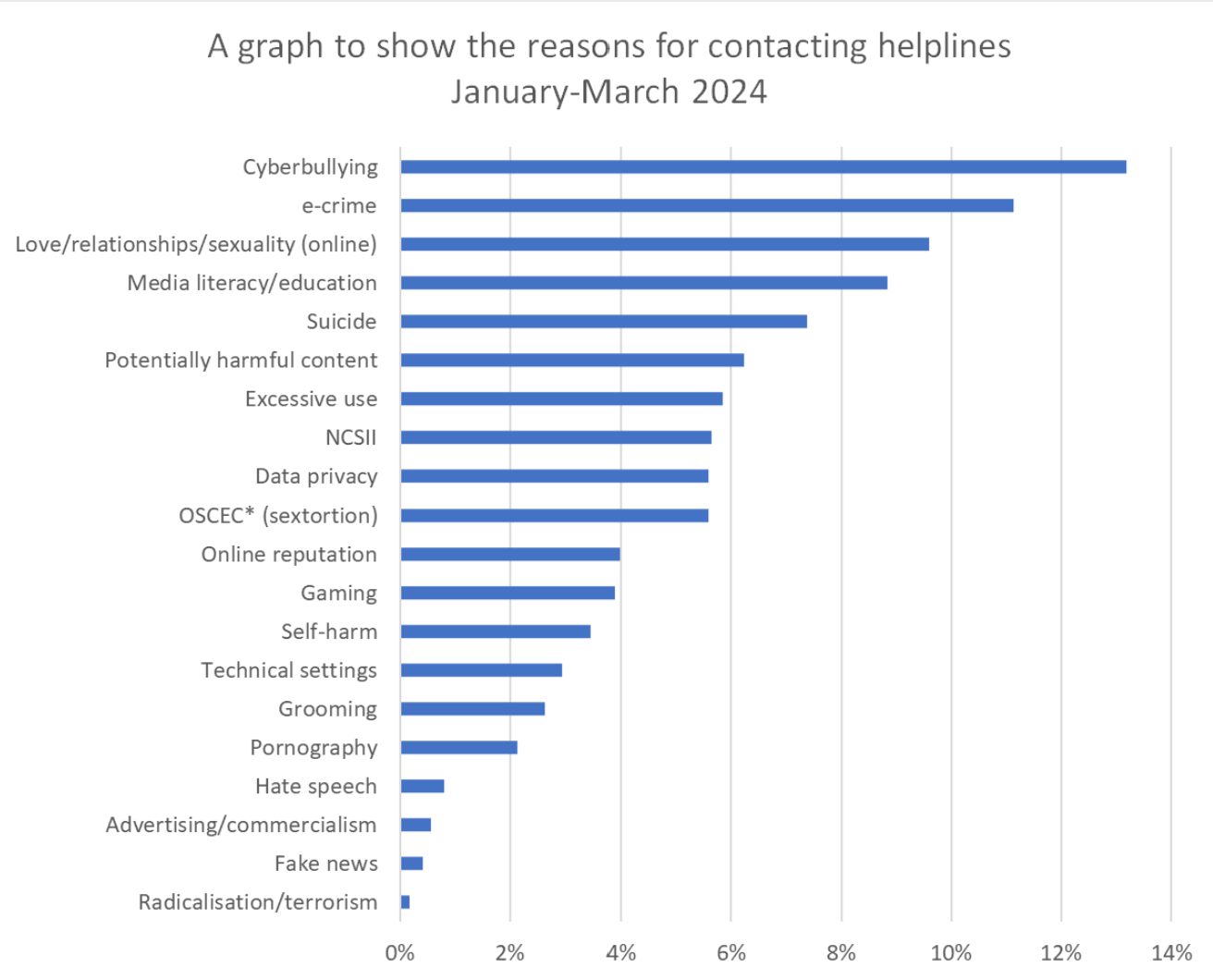The Insafe network of helplines collects data about the types of calls received, which is analysed every three months to examine possible trends and emerging issues. The most recent helpline data covers the period from January to March 2024. This quarter, more than 16,500 contacts were made to the helpline network.

Almost 60 per cent of contacts come from teenagers, and almost 60 per cent of all contacts are from those identifying as female. Teenagers (12–18-year-olds) are the group which makes the most use of Insafe helpline services and, of course, for many helplines, these young people are the main target audience. Around seven and a half per cent of contacts were received from 5–11-year-olds – this represents an increase of three percentage points compared to the previous quarter. Contacts from parents are significant, accounting for 28 per cent of the total.
This reporting period saw several helplines citing an increase in contacts relating to e-crime, which is defined as chain emails, phishing sites, identity theft, fraud, data theft, copyright infringement, hacking, piracy, and so on. This category has been accounting for an increasing percentage of contacts over the last couple of years, and there has been a rise of two percentage points on the previous quarter. Some helplines also reported an increase in contacts from both adults and children seeking help with technical settings on devices and platforms.
Cyberbullying remains the most common reason for contacting a helpline with over 13 per cent of contacts concerning this.
Six per cent of contacts related to excessive use during this reporting period – this represents the highest proportion of calls concerning this issue, and it has risen by two percentage points since Q1 of 2023.
An infographic provides a visual representation of many of the above points.
Insafe contacts are now grouped into four main areas:
- Being online (incorporating advertising and commercialism, data privacy, fake news, media literacy/education, potentially harmful content, self-harm, suicide and technical settings. This area accounted for 35 per cent of all contacts.
- Online violence (incorporating cyberbullying, e-crime, hate speech and radicalisation/terrorism) accounted for 25 per cent of all contacts. This was a five per cent increase on the previous reporting period.
- Online activities/relations (incorporating excessive use, gaming, love, relationships, sexuality (online), online reputation, and pornography) which accounted for 26 per cent of all calls.
- Online sexual abuse and violence (incorporating grooming, the non-consensual sharing of intimate images (NCSII), and the online sexual coercion and extortion of minors (which used to be referred to as sextortion). This area accounted for 15 per cent of all contacts made.

| Reason for contacting the helpline | Percentage |
|---|---|
| Radicalisation/terrorism | 0.18 per cent |
| Advertising/commercialism | 0.41 per cent |
| Hate speech | 0.55 per cent |
| Pornography | 0.80 per cent |
| Grooming | 2.62 per cent |
| Technical settings | 2.95 per cent |
| Self-harm | 3.46 per cent |
| Gaming | 3.89 per cent |
| Online reputation | 3.98 per cent |
| Online sexual coercion and extortion of children (sextortion) | 5.58 per cent |
| Data privacy | 5.59 per cent |
| NCSII | 5.65 per cent |
| Excessive use | 5.84 per cent |
| Potentially harmful content | 6.23 per cent |
| Suicide | 7.37 per cent |
| Media literacy/education | 8.84 per cent |
| Love/relationships/sexuality (online) | 9.60 per cent |
| e-crime | 11.14 per cent |
| Cyberbullying | 13.18 per cent |
Find out more about country-based helpline services operating as part of the national Safer Internet Centre at www.betterinternetforkids.eu/sic.
Find news updates on helpline services at www.betterinternetforkids.eu/practice/helplines.
The Insafe network of helplines collects data about the types of calls received, which is analysed every three months to examine possible trends and emerging issues. The most recent helpline data covers the period from January to March 2024. This quarter, more than 16,500 contacts were made to the helpline network.

Almost 60 per cent of contacts come from teenagers, and almost 60 per cent of all contacts are from those identifying as female. Teenagers (12–18-year-olds) are the group which makes the most use of Insafe helpline services and, of course, for many helplines, these young people are the main target audience. Around seven and a half per cent of contacts were received from 5–11-year-olds – this represents an increase of three percentage points compared to the previous quarter. Contacts from parents are significant, accounting for 28 per cent of the total.
This reporting period saw several helplines citing an increase in contacts relating to e-crime, which is defined as chain emails, phishing sites, identity theft, fraud, data theft, copyright infringement, hacking, piracy, and so on. This category has been accounting for an increasing percentage of contacts over the last couple of years, and there has been a rise of two percentage points on the previous quarter. Some helplines also reported an increase in contacts from both adults and children seeking help with technical settings on devices and platforms.
Cyberbullying remains the most common reason for contacting a helpline with over 13 per cent of contacts concerning this.
Six per cent of contacts related to excessive use during this reporting period – this represents the highest proportion of calls concerning this issue, and it has risen by two percentage points since Q1 of 2023.
An infographic provides a visual representation of many of the above points.
Insafe contacts are now grouped into four main areas:
- Being online (incorporating advertising and commercialism, data privacy, fake news, media literacy/education, potentially harmful content, self-harm, suicide and technical settings. This area accounted for 35 per cent of all contacts.
- Online violence (incorporating cyberbullying, e-crime, hate speech and radicalisation/terrorism) accounted for 25 per cent of all contacts. This was a five per cent increase on the previous reporting period.
- Online activities/relations (incorporating excessive use, gaming, love, relationships, sexuality (online), online reputation, and pornography) which accounted for 26 per cent of all calls.
- Online sexual abuse and violence (incorporating grooming, the non-consensual sharing of intimate images (NCSII), and the online sexual coercion and extortion of minors (which used to be referred to as sextortion). This area accounted for 15 per cent of all contacts made.

| Reason for contacting the helpline | Percentage |
|---|---|
| Radicalisation/terrorism | 0.18 per cent |
| Advertising/commercialism | 0.41 per cent |
| Hate speech | 0.55 per cent |
| Pornography | 0.80 per cent |
| Grooming | 2.62 per cent |
| Technical settings | 2.95 per cent |
| Self-harm | 3.46 per cent |
| Gaming | 3.89 per cent |
| Online reputation | 3.98 per cent |
| Online sexual coercion and extortion of children (sextortion) | 5.58 per cent |
| Data privacy | 5.59 per cent |
| NCSII | 5.65 per cent |
| Excessive use | 5.84 per cent |
| Potentially harmful content | 6.23 per cent |
| Suicide | 7.37 per cent |
| Media literacy/education | 8.84 per cent |
| Love/relationships/sexuality (online) | 9.60 per cent |
| e-crime | 11.14 per cent |
| Cyberbullying | 13.18 per cent |
Find out more about country-based helpline services operating as part of the national Safer Internet Centre at www.betterinternetforkids.eu/sic.
Find news updates on helpline services at www.betterinternetforkids.eu/practice/helplines.
- sexuality helpline excessive use of technology cyberviolence
Related content
- < Previous article
- Next article >












